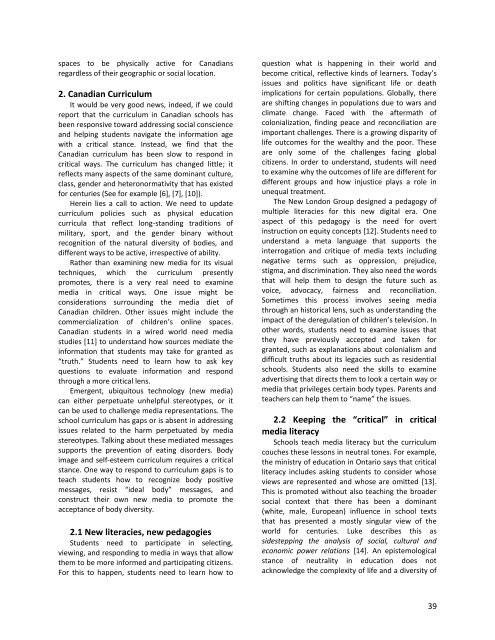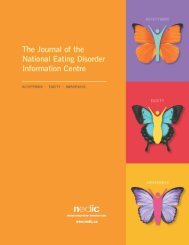NEDIC Conference Journal 2018
Create successful ePaper yourself
Turn your PDF publications into a flip-book with our unique Google optimized e-Paper software.
spaces to be physically active for Canadians<br />
regardless of their geographic or social location.<br />
2. Canadian Curriculum<br />
It would be very good news, indeed, if we could<br />
report that the curriculum in Canadian schools has<br />
been responsive toward addressing social conscience<br />
and helping students navigate the information age<br />
with a critical stance. Instead, we find that the<br />
Canadian curriculum has been slow to respond in<br />
critical ways. The curriculum has changed little; it<br />
reflects many aspects of the same dominant culture,<br />
class, gender and heteronormativity that has existed<br />
for centuries (See for example [6], [7], [10]).<br />
Herein lies a call to action. We need to update<br />
curriculum policies such as physical education<br />
curricula that reflect long-standing traditions of<br />
military, sport, and the gender binary without<br />
recognition of the natural diversity of bodies, and<br />
different ways to be active, irrespective of ability.<br />
Rather than examining new media for its visual<br />
techniques, which the curriculum presently<br />
promotes, there is a very real need to examine<br />
media in critical ways. One issue might be<br />
considerations surrounding the media diet of<br />
Canadian children. Other issues might include the<br />
commercialization of children’s online spaces.<br />
Canadian students in a wired world need media<br />
studies [11] to understand how sources mediate the<br />
information that students may take for granted as<br />
“truth.” Students need to learn how to ask key<br />
questions to evaluate information and respond<br />
through a more critical lens.<br />
Emergent, ubiquitous technology (new media)<br />
can either perpetuate unhelpful stereotypes, or it<br />
can be used to challenge media representations. The<br />
school curriculum has gaps or is absent in addressing<br />
issues related to the harm perpetuated by media<br />
stereotypes. Talking about these mediated messages<br />
supports the prevention of eating disorders. Body<br />
image and self-esteem curriculum requires a critical<br />
stance. One way to respond to curriculum gaps is to<br />
teach students how to recognize body positive<br />
messages, resist “ideal body” messages, and<br />
construct their own new media to promote the<br />
acceptance of body diversity.<br />
2.1 New literacies, new pedagogies<br />
Students need to participate in selecting,<br />
viewing, and responding to media in ways that allow<br />
them to be more informed and participating citizens.<br />
For this to happen, students need to learn how to<br />
question what is happening in their world and<br />
become critical, reflective kinds of learners. Today’s<br />
issues and politics have significant life or death<br />
implications for certain populations. Globally, there<br />
are shifting changes in populations due to wars and<br />
climate change. Faced with the aftermath of<br />
colonialization, finding peace and reconciliation are<br />
important challenges. There is a growing disparity of<br />
life outcomes for the wealthy and the poor. These<br />
are only some of the challenges facing global<br />
citizens. In order to understand, students will need<br />
to examine why the outcomes of life are different for<br />
different groups and how injustice plays a role in<br />
unequal treatment.<br />
The New London Group designed a pedagogy of<br />
multiple literacies for this new digital era. One<br />
aspect of this pedagogy is the need for overt<br />
instruction on equity concepts [12]. Students need to<br />
understand a meta language that supports the<br />
interrogation and critique of media texts including<br />
negative terms such as oppression, prejudice,<br />
stigma, and discrimination. They also need the words<br />
that will help them to design the future such as<br />
voice, advocacy, fairness and reconciliation.<br />
Sometimes this process involves seeing media<br />
through an historical lens, such as understanding the<br />
impact of the deregulation of children’s television. In<br />
other words, students need to examine issues that<br />
they have previously accepted and taken for<br />
granted, such as explanations about colonialism and<br />
difficult truths about its legacies such as residential<br />
schools. Students also need the skills to examine<br />
advertising that directs them to look a certain way or<br />
media that privileges certain body types. Parents and<br />
teachers can help them to “name” the issues.<br />
2.2 Keeping the “critical” in critical<br />
media literacy<br />
Schools teach media literacy but the curriculum<br />
couches these lessons in neutral tones. For example,<br />
the ministry of education in Ontario says that critical<br />
literacy includes asking students to consider whose<br />
views are represented and whose are omitted [13].<br />
This is promoted without also teaching the broader<br />
social context that there has been a dominant<br />
(white, male, European) influence in school texts<br />
that has presented a mostly singular view of the<br />
world for centuries. Luke describes this as<br />
sidestepping the analysis of social, cultural and<br />
economic power relations [14]. An epistemological<br />
stance of neutrality in education does not<br />
acknowledge the complexity of life and a diversity of<br />
39




